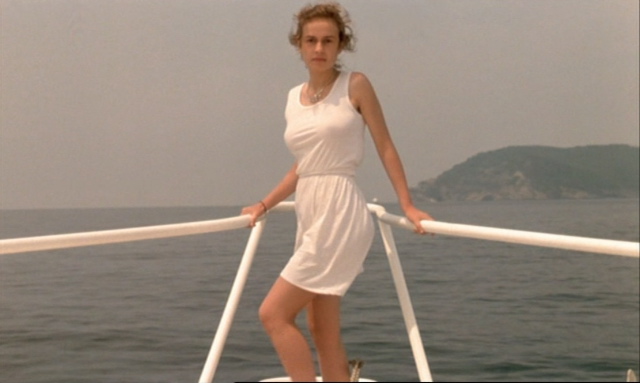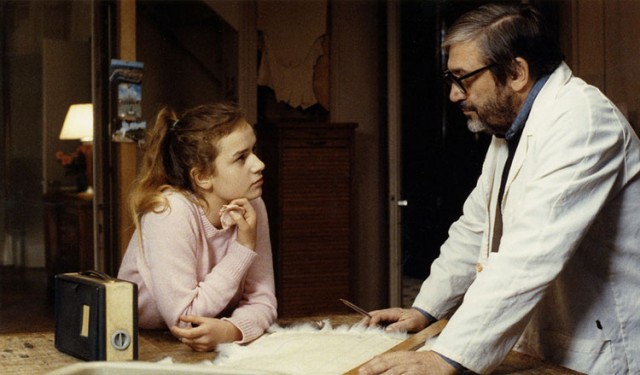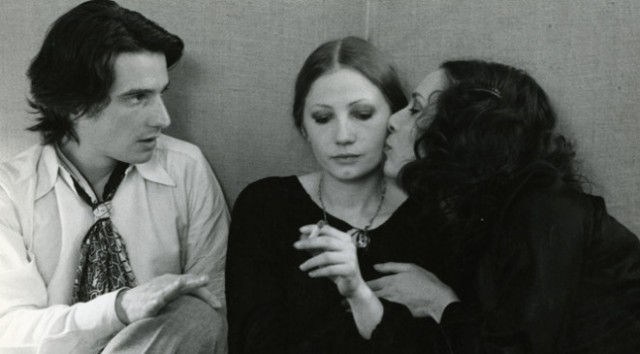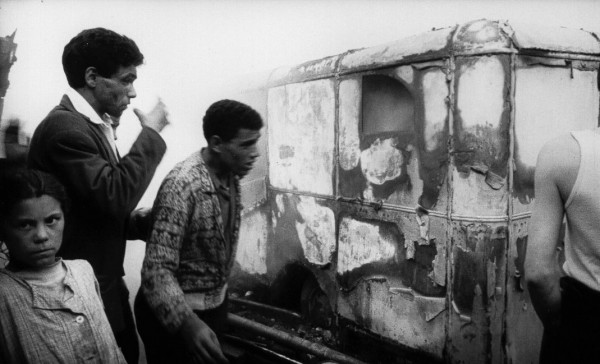
Isabelle will be in person — not on the phone — at the Quad for Q&As following screenings of Jean-Paul Salomé’s La Syndicaliste
Who: Isabelle Huppert
What: Screenings followed by Q&As
Where: Quad Cinema, 34 West 13th St. between Fifth & Sixth Aves.
When: December 1-2 (festival continues all month)
Why: For more than half a century, French actress Isabelle Huppert has been one of cinema’s brightest stars. She’s appeared in more than 130 films, working with a who’s who of international directors, including Claude Chabrol, Márta Mészáros, Jean-Luc Godard, Diane Kurys, Bertrand Tavernier, David O. Russell, Joachim Trier, Hal Hartley, Ursula Meier, Bertrand Blier, Curtis Hanson, Hong Sang-soo, Ira Sachs, Paul Verhoeven, Wes Anderson, Michael Cimino, and Michael Haneke. She’s also done more than thirty plays, including 4.48 Psychose, The Maids, and The Mother in New York.
Huppert will be back in New York on December 1 and 2, participating in Q&As following screenings of Jean-Paul Salomé’s Venice Film Festival selection La Syndicaliste, a thriller in which Huppert plays real-life Irish trade unionist and whistleblower Maureen Kearney. Huppert will be at the Quad for the 7:15 show on December 1 and the 4:15 and 7:15 shows on December 2. The Quad will also be presenting “Restorations Starring Isabelle Huppert,” part of its ongoing “From the Vault: The Cohen Film Collection” series, on three Wednesdays in December: Benoît Jacquot’s 1999 Keep It Quiet on December 6, André Téchiné’s 1979 The Brontë Sisters on December 13, and Maurice Pialat’s 1980 Loulou on December 20. Finally, her latest film, François Ozon’s The Crime Is Mine, a murder mystery adapted from a 1934 play, opens exclusively at the Quad on December 25. Huppert, who turned seventy this past March, is as resplendent as ever, so these Q&As are must-see events.
[Mark Rifkin is a Brooklyn-born, Manhattan-based writer and editor; you can follow him on Substack here.]

 Sandrine Bonnaire won the César for Most Promising Actress in her film debut, Maurice Pialat’s À nos amours, and she has more than fulfilled that promise in her still-vibrant thirty-plus-year career. Bonnaire stars as fifteen-year-old Suzanne, who suddenly becomes sexually promiscuous one summer. “‘Don’t you think one can die of love?’” she asks, rehearsing for a camp play. “‘You told me you loved me. What kind of a world is this?’” As Suzanne flits about from lover to lover, her family begins to notice a change in her and is not very happy about it. Her mother (Evelyne Ker) and father (Pialat) are on the verge of a breakup, and her creepy brother, Robert (Dominique Besnehard), doesn’t really get any of it; all three seem emotionally stunted, able only to express their feelings about Suzanne’s behavior by striking her physically. Suzanne is a decidedly contemporary Western European ingénue; the film casts no aspersions on her and does not judge her actions, even if her mother and Robert do. Bonnaire was around the same age as her character when she made the film, which contains significant nudity and bed scenes if not graphic depictions of sex; the film would likely have been wildly controversial if made in Hollywood with a fifteen-year-old American actress. Suzanne’s father, a furrier who has left his wife for another woman, is sad that she has lost one of her dimples, a sign of her maturing; when she was a baby, he wanted to protect her from kidnapping, but now he knows and accepts that he no longer has control over her life. Suzanne enjoys the sex she is having but is obviously seeking something more; but Pialat, the director of the film and who also plays the fictional father, never delves too deeply into her psyche, refusing to provide any easy answers or simplistic resolutions for this complex coming-of-age story.
Sandrine Bonnaire won the César for Most Promising Actress in her film debut, Maurice Pialat’s À nos amours, and she has more than fulfilled that promise in her still-vibrant thirty-plus-year career. Bonnaire stars as fifteen-year-old Suzanne, who suddenly becomes sexually promiscuous one summer. “‘Don’t you think one can die of love?’” she asks, rehearsing for a camp play. “‘You told me you loved me. What kind of a world is this?’” As Suzanne flits about from lover to lover, her family begins to notice a change in her and is not very happy about it. Her mother (Evelyne Ker) and father (Pialat) are on the verge of a breakup, and her creepy brother, Robert (Dominique Besnehard), doesn’t really get any of it; all three seem emotionally stunted, able only to express their feelings about Suzanne’s behavior by striking her physically. Suzanne is a decidedly contemporary Western European ingénue; the film casts no aspersions on her and does not judge her actions, even if her mother and Robert do. Bonnaire was around the same age as her character when she made the film, which contains significant nudity and bed scenes if not graphic depictions of sex; the film would likely have been wildly controversial if made in Hollywood with a fifteen-year-old American actress. Suzanne’s father, a furrier who has left his wife for another woman, is sad that she has lost one of her dimples, a sign of her maturing; when she was a baby, he wanted to protect her from kidnapping, but now he knows and accepts that he no longer has control over her life. Suzanne enjoys the sex she is having but is obviously seeking something more; but Pialat, the director of the film and who also plays the fictional father, never delves too deeply into her psyche, refusing to provide any easy answers or simplistic resolutions for this complex coming-of-age story. 

 Jean-Pierre Léaud gives a bravura performance in Jean Eustache’s New Wave classic about love and sex in Paris following the May 1968 cultural revolution. Léaud stars as Alexandre, a jobless, dour flaneur who rambles on endlessly about politics, cinema, music, literature, sex, women’s lib, and lemonade while living with current lover Marie (Bernadette Lafont), obsessing over former lover Gilberte (Isabelle Weingarten), and starting an affair with new lover Veronika (Françoise Lebrun), a quiet nurse with a rather open sexual nature. The film’s three-and-a-half-hour length will actually fly by as you become immersed in the complex characters, the fascinating dialogue, and the excellent acting. Much of the film consists of long takes in which Alexandre shares his warped view of life and art in small, enclosed spaces, the static camera focusing either on him or his companion. Someone at BAM has a wicked sense of humor, as The Mother and the Whore is screening on Mother’s Day at 2:30 & 7:00 as part of the BAMcinématek series “Booed at Cannes,” consisting of films that did not exactly thrill the Cannes glitterati but have gone on to gain their own unique reputations, including Maurice Pialat’s Under the Sun of Satan, Michelangelo Antonioni’s L’eclisse, David Lynch’s Wild at Heart, and David Cronenberg’s Crash.
Jean-Pierre Léaud gives a bravura performance in Jean Eustache’s New Wave classic about love and sex in Paris following the May 1968 cultural revolution. Léaud stars as Alexandre, a jobless, dour flaneur who rambles on endlessly about politics, cinema, music, literature, sex, women’s lib, and lemonade while living with current lover Marie (Bernadette Lafont), obsessing over former lover Gilberte (Isabelle Weingarten), and starting an affair with new lover Veronika (Françoise Lebrun), a quiet nurse with a rather open sexual nature. The film’s three-and-a-half-hour length will actually fly by as you become immersed in the complex characters, the fascinating dialogue, and the excellent acting. Much of the film consists of long takes in which Alexandre shares his warped view of life and art in small, enclosed spaces, the static camera focusing either on him or his companion. Someone at BAM has a wicked sense of humor, as The Mother and the Whore is screening on Mother’s Day at 2:30 & 7:00 as part of the BAMcinématek series “Booed at Cannes,” consisting of films that did not exactly thrill the Cannes glitterati but have gone on to gain their own unique reputations, including Maurice Pialat’s Under the Sun of Satan, Michelangelo Antonioni’s L’eclisse, David Lynch’s Wild at Heart, and David Cronenberg’s Crash.